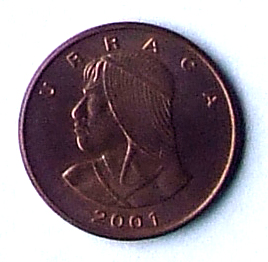Urracá facts for kids
Quick facts for kids
Urracá
|
|
|---|---|

Urracá depicted on the obverse of the Panamanian Centesimo coin.
|
|
| Died | 1531 Nata de los Caballeros
|
| Nationality | Ngäbe |
| Occupation | Cacique |
Urracá (died 1531) was a brave Ngäbe Amerindian leader, also known as a cacique. He lived in what is now Panama. Urracá is famous for fighting against the Spanish conquistadors, who were explorers and soldiers from Spain.
The Spanish captured Urracá once when he came to talk about peace. They put him in a cage and planned to send him to Spain. But Urracá was smart and escaped! He returned to his mountain village and lived freely until he died. People remember him as a great leader who stood up to the Spanish Empire. He is honored in Panama, and his picture is on the centesimo coin.
Contents
Urracá's Fight for Freedom
After Panama City was founded in 1519, Spanish leaders like Pedrarias Dávila began exploring the country. They hoped to find villages rich in gold. The Spanish took over the Veragua province, which had a lot of gold. Urracá's land was near the town of Nata de los Caballeros, which the Spanish built in 1520. This town was a base for them to explore Central America.
Urracá and his people fought bravely against the Spanish for almost nine years. They often defeated the Spanish soldiers, who were led by Gaspar de Espinosa. When Espinosa left, Francisco de Compañón took his place. Urracá attacked the Spanish warriors. Compañón asked for help, and Pedrarias sent more soldiers led by Hernán Ponce de León.
Uniting Tribes Against the Spanish
Urracá was a clever leader. He managed to make friends with other tribes that were usually enemies. They all united to fight the Spanish together. Many caciques, like Ponca, Dures, and Guisia, joined Urracá.
Ponce de León helped the Spanish break Urracá's attack on Nata. Then Pedrarias arrived with even more soldiers. There were many fierce battles, but neither side could win completely. In one battle, Urracá's forces defeated Captain Diego de Albitres. He escaped and told the governor of Castilla del Oro what happened.
How Urracá Was Captured
The Spanish, led by Compañón, tried to trick Urracá. They sent messengers to his land, asking him to come to Nata de los Caballeros for peace talks. Urracá agreed and went with two of his men. But Compañón captured him! They sent Urracá to Nombre de Dios to be shipped to Spain.
However, Urracá was too smart. He escaped and found his way back to his people. He continued to fight against the Spanish for several more years, always remaining free.
Remembering Urracá Today
In the city of Santiago, there is a statue of Urracá. It shows him looking like a warrior, ready to fight the Spanish.
The Asociación Nacional de Scouts de Panamá also honors Urracá. Their highest award for great community service is called the Scout Urracá.
"... He was so brave and courageous, wise and skillful in war, not just to defeat the Spaniards who oppressed him ... being a man of judgment and courageous, and knowing full well how it is a war against the enemy ..." Bartolomé de las Casas, History of the Indies.
See also
 In Spanish: Urracá para niños
In Spanish: Urracá para niños
- Lempira (Lenca ruler)

